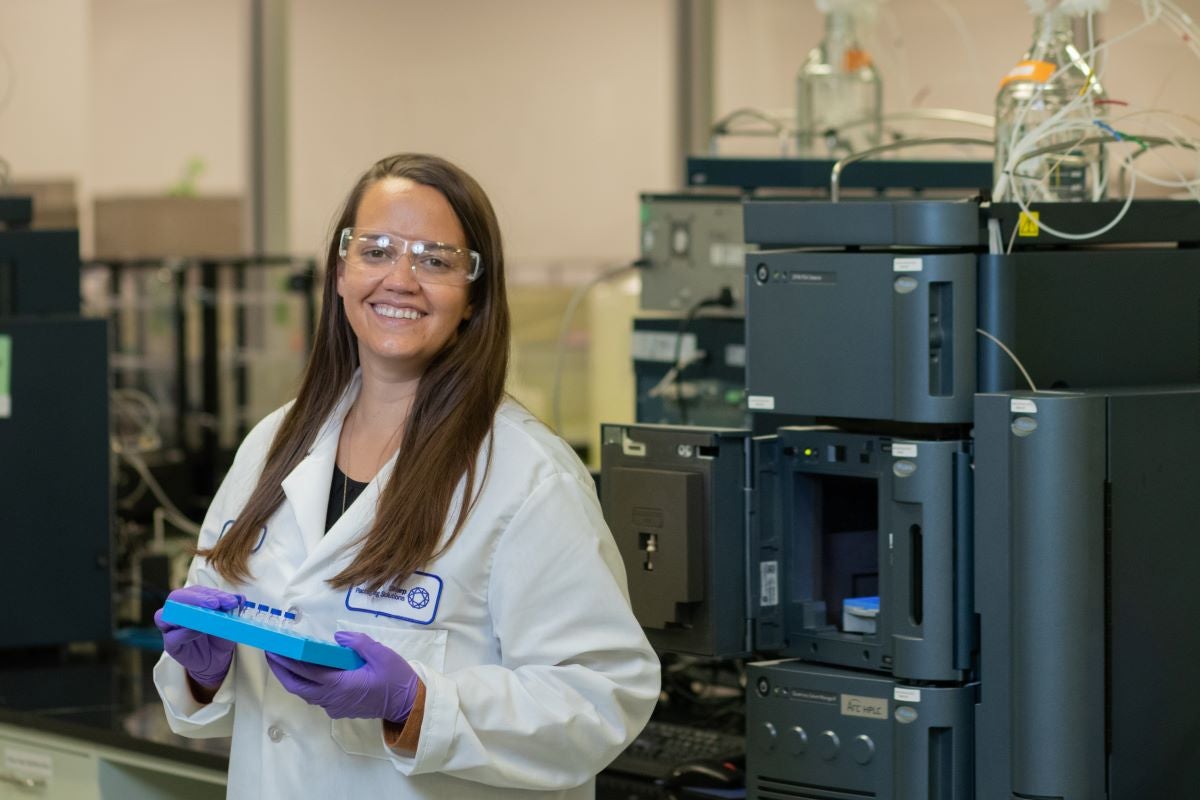
The pharmaceutical industry is already highly competitive. It’s a business driven by the compassionate desire to discover and develop therapies to improve patient lives, and financially from the desire to benefit from market exclusivity.
With the recent explosion in the use of artificial intelligence-supported drug discovery, the industry will soon be inundated with new drug substances, and each unique compound will need to be given the analytical due diligence to suitably verify its safety, purity, and efficacy.
With all these new drugs anticipated to advance through clinical development, will the legacy modus operandi still be sufficient? And if not, what needs to change?

We asked Robert Feltz, the Director of Analytical and Formulation Services at Sharp Clinical, a multi-faceted contract development and manufacturing organization (CDMO) that offers under-one-roof drug product formulation and development, manufacturing, packaging, analytical testing, IRT, and supply chain management services across all phases of clinical development to share his thoughts.
In regulated pharmaceutical analysis, there is a constant need to maintain speed without sacrificing accuracy. “When we’re working on a new molecule or formulation, we let the data guide us,” Feltz explained. “And using advanced analytical techniques is the fastest way of generating that data.”
Technological advancements continually improve analytical instruments, making them more sensitive, selective, and efficient. R&D teams need to keep themselves updated with these innovations to stay competitive. But with all the recent technological changes, one thing remains consistent: “Find and hire the best people, give them modern and adaptive technology, and build an infrastructure that allows for rapid data review and reporting,” says Feltz. “That strategy is timeless.”
The crucial importance of efficient and accurate analytical testing services
To respond to the increasing demands of timely and accurate results for all the new AI-driven drugs, CDMOs must streamline their manufacturing, packaging, testing, storage, and distribution strategies.
“Regulatory agencies like the FDA require extensive analytical data during drug review and approval,” Feltz explains. “Accurate, reliable, and rapid analytical testing is essential for submitting comprehensive submissions and gaining regulatory approval to market the drug. Any deficiencies in analytical data can lead to drug application delays or rejections.”
When speed and accuracy matter, ask these ten critical questions:
“When building the right testing program for each Investigational Medicinal Product (IMP), you start by asking the right questions,” says Feltz: “It begins with the end goal in mind.”
By asking these questions, you’ll facilitate the collaborative process needed to turn project goals into a realistic timeline:
What is the purpose of the IMP? Understanding the specific objectives of the investigational product is crucial. Is it intended for upcoming clinical trials, alternate formulation development, non-clinical research, or something else entirely? Knowing the scope will influence the focus of the testing program. Defining the scope of the study as soon as possible will allow the R&D team to tailor their testing approach to maximize the efficiency of their development efforts, ultimately minimizing the time it takes to generate data.
What are the critical quality attributes (CQAs) of the IMP? Identify the characteristics that define the product’s quality, safety, and efficacy. CQAs could include purity, potency, stability, bioavailability, and other relevant parameters. Each CQA could require a test to be developed and validated before batch release. It’s also essential to establish what are not CQAs.
Feltz says: “The most important thing at this stage is to become an expert in your product. Each excipient in the formulation should play a role, or it shouldn’t be there. If it’s a functional excipient, you should have a qualified test to quantitate it and generate the data needed to establish specifications for it.”
“On the other hand,” Feltz continues, “don’t test mindlessly. Each piece of data takes time to generate and should add value to the overall submission goal. Work to understand the chemistry of your product. What makes it degrade? How much preservative is needed before the microbial properties are impacted? Are there any polymorphic concerns? Determine the product’s vulnerabilities, establish specifications that assure its continued effectiveness, and develop tests to assess when a product is trending toward its specification limit.”
What is the desired manufacturing process? Your formulation development work should provide a thorough understanding of the finished product’s release properties. Feltz explains: “Once you understand those properties, work backward from the desired outcome to reverse engineer a manufacturing process that achieves the desired effect.” Decision-makers should know if the procedure involves complex steps, novel materials, technologies, or logistical risks.
Which Regulatory Guidelines Apply? Different regulatory guidelines may apply depending on the intended use and location of the IMP. Complying with these guidelines at program initiation is critical for efficient development. “For example,” says Feltz, “sampling and testing requirements differ between regions, so those must be taken into account at the program’s outset so that you avoid costly delays or material shortages.”
What analytical techniques and methods are already available? Consider all available analytical technologies. Innovative companies know that time spent on development is difficult to regain, so they invest in the best technologies for their product. “One example of this is in the separation and detection field,” explains Feltz. “Supercritical fluid chromatography and charged aerosol detection are two technologies gaining acceptance and usage, and both can offer significant time savings over legacy analytical techniques.”
What sample size and testing frequency are needed? Determine the appropriate number of samples and testing frequency. Establish your sample size and testing regimen using statistical considerations and stability study requirements. “It’s common to set down excess samples at the outset of a stability study with the assumption that testing requirements could always change as a result of regulatory review,” explains Feltz. “You never want to be in a situation where you need to repeat a multi-year stability study.”
What shelf life would you like to have? Stability data is crucial for determining shelf-life and storage recommendations. “And don’t restrict these conversations to just technical personnel,” cautions Feltz. “Sales and marketing personnel have an interest in this as well. Few markets will tolerate a short shelf-life product.”
What’s your budget? Consider available funding and balance the need for comprehensive testing with the practical constraints of your company’s budget allocation. “This goes back to being an expert in your product,” says Feltz. “Focus on a scope of work that ensures that all efforts are value-added.”
What are your timeline and milestones? Set clear timelines and milestones. “Knowing and communicating this information to your CDMO ensures that the testing progresses as planned and aligns with the overall drug development timeline,” reminds Feltz. “Making it more likely that expectations are understood between both parties.”
Will your testing be prioritized? Undoubtedly, having dedicated analytical services at your CDMO offers more flexibility in prioritizing testing needs. Feltz explains: “Urgent samples and critical tests are given immediate attention, reducing potential delays in product release. You have near-instant access to the personnel working on your product, which can have a significant impact when it comes to decision-making because they’ll be working as hard on your product as you do. It’s a partnership, after all.”
The benefits of having analytical services under the same roof as manufacturing
Outsourcing your analytical services and manufacturing to the same site can enable real-time monitoring, control, and quick adjustments for consistent product quality. On-site analytical services reduce turnaround time, benefiting process development, scale-up, and routine quality control.
Other benefits include improved confidentiality, faster decision-making and collaboration, and cost efficiency.
“With analytical services on-site, there is no need to send samples to external laboratories, reducing turnaround time for test results,” explains Feltz. “Physical proximity fosters better communication and collaboration between analytical scientists and manufacturing teams, which enhances problem-solving. Teams can work together to identify root causes and implement corrective actions promptly. Further, sharing facilities and equipment between departments optimizes resources, resulting in cost savings and increased efficiency across both areas.”
Partnering with Sharp
Sharp’s team of skilled analytical scientists are experts in pharmaceutical testing. With state-of-the-art laboratories and instruments, Sharp ensures accurate and reliable results.
“Drug developers can confidently outsource the analytical testing of their IMPs to us because of our expertise,” says Feltz, “As well as our regulatory compliance, customized approach, data integrity, and commitment to timely and reliable results. Sharp’s focus on transparency, risk mitigation, and client communication further reinforces drug developers’ trust in our hands for their critical analytical testing needs.”
Download the paper below for more information on how Sharp can support analytical testing and efficient clinical development.

Sign up for our daily news round-up!
Give your business an edge with our leading industry insights.
